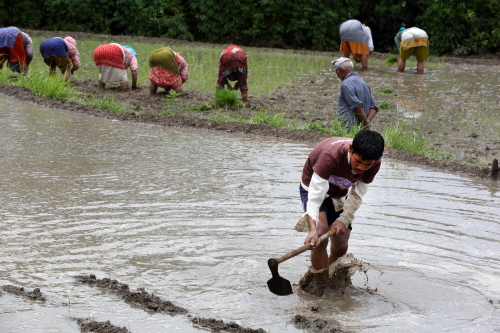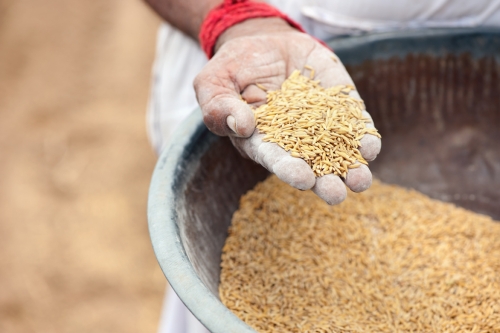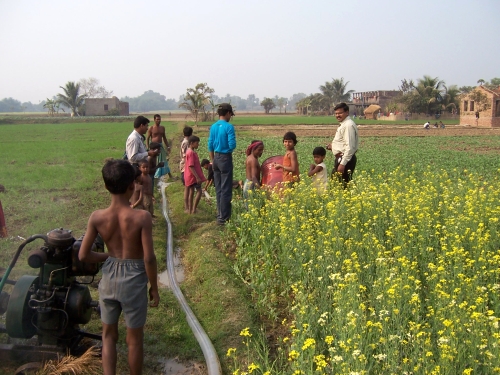Report calls for more action to combat the region’s contamination challenge

(Photo: Jim Holmes / IWMI)
Urgent new research is needed to better understand the full extent of arsenic contamination in food and more broadly in soil and water in South Asia, according to a new review published by the International Water Management Institute (IWMI).
[pullquote type=”pullquote3″ content=”it’s not so widely known that food crops can absorb arsenic” quote_icon=”yes” align=”right” textcolor=”#2a9832″]it’s not so widely known that food crops can absorb arsenic[/pullquote]
The Eastern Ganges Basin (EGB) is a major water catchment area that covers parts of India (Bihar and West Bengal), Bangladesh and Nepal. An estimated 75% of the 350 million people that live in the region are vulnerable to arsenic exposure through water and food.
The IWMI report analyzes years of wide-ranging research into the region’s ‘arsenic crisis’ undertaken by a range of research organizations. While the authors find progress in some regions, it is lacking in others.
For instance, in Bangladesh, the United Nations Children’s Fund (UNICEF) and the Department of Public Health Engineering (DPHE) have carried out significant work in identifying and finding solutions for arsenic contamination in parts of the country. Then again, no detailed study has been conducted since a groundwater arsenic survey was carried out by the British Geological Survey (BGS) during 1998-1999. Likewise, only a limited number of studies were found in Bihar, India, and in the Terai region of Nepal.
The authors of the review call to attention the lack of data covering the rest of the affected areas of the EGB. They identify the need for up-to-date research inclusive of the floodplains of the EGB and, if ignored, the dangers that follow.
Long-term exposure to arsenic is linked to a range of illnesses. While the hazardous element can occur naturally in soil, rock and groundwater, it can also accumulate as a result of human activity.
The report highlights the possibility of transmission of arsenic from soil and irrigation water into the food chain, particularly through the consumption of rice, which is a major staple food in the EGB.

(Photo: Hamish John Appleby / IWMI)
As well as contamination of irrigation water itself, flooding paddy fields can also result in arsenic moving from the soil to accumulate in rice grains through the roots. While cooking rice has been shown to reduce arsenic levels, the report notes that rice consumption is one source of transmission of arsenic to humans, but there is insufficient evidence to establish the likely contribution to ill-health.
The report also points out that vegetables – particularly leafy types – also contain potentially dangerous levels of arsenic.
“Many people are already aware of how dangerous drinking arsenic-contaminated water can be,” said N. Rajmohan, Special Project Scientist (Vadose Zone Modeling), IWMI, and co-author of the report. “But it’s not so widely known that food crops can absorb arsenic too – from water used for irrigation and from the soil. One contribution to make progress in protecting the people living in the EGB from the scourge of arsenic, would be to redouble our efforts to expand and improve our research to better understand the likely risk from arsenic through the food chain and develop implementable programs as soon as possible.”

(Photo: Aditi Mukherji/IWMI)
The IWMI review explores numerous case studies. According to available information, groundwater in Bangladesh and the Indian state of West Bengal are the worst affected. Due to the lack of data in Bihar, India, and in the Terai region of Nepal, the total arsenic load in the food chain and its impact on human health in those regions is not clear.
The authors of the report recommend the following:
- Systematic long-term monitoring and analysis of arsenic contamination of groundwater, soils and food across the EGB to evaluate the extent of the ‘arsenic crisis’. This includes the need to test numerous wells in areas where this is not happening and where data are lacking to determine the magnitude of groundwater contamination.
- Update the database available for Bangladesh to include the rest of the EGB to help governments, researchers, nongovernmental organizations (NGOs) and volunteers to identify hot spots of arsenic contamination.
- Collaboration between institutes currently researching arsenic contamination in the EGB, to avoid duplication of earlier work and enable improved coordination in future research.
Read the report:
Rajmohan, N.; Prathapar, S. A. 2014. Extent of arsenic contamination and its impact on the food chain and human health in the eastern Ganges Basin: a review. Colombo, Sri Lanka: International Water Management Institute (IWMI). 47p. (IWMI Working Paper 161). doi: 10.5337/2014.224
- Rajmohan is a Special Project Scientist (Vadose Zone Modeling) at the International Water Management Institute (IWMI), New Delhi, India.

